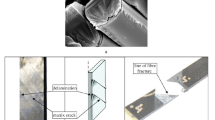Abstract
Experimental and finite-element analyses are presented for the anisotropic states of stress, strain and fracture of a glass-epoxy plate containing a circular hole and subjected to uniaxial tension. Strains were experimentally measured using foil gages, moiré and birefringent coating. Stresses are computed in the linear range from the measured strains. While the hole reduces the plate strength by a factor of two, the maximum tensile strain at fracture is greater than the ultimate strain in a plate without a hole. Fracture consists of crack initiation at the hole boundary but off the horizontal axis. Away from the hole, failure is accompanied by considerable delamination. Discontinuous crack propagation is present.
Similar content being viewed by others
References
Kirsch, G., “Die Theorie der Elasticitat und die Bedurfnisse der Festigkeitlehre,”Z. Ver. deut. Ing.,32 797–807 (1898).
Howland, R. C. J., “On the Stress in the Neighborhood of a Circular Hole in a Strip Under Tension,”Trans. Roy. Soc. London, Series A.,229,49–86 (1930).
Lekhnitskii, S. G., Theory of Elasticity of an Anisotropic Elastic Body, P. Fern, Trans., J. J. Brandstatter, Eded. Holden-Day Inc., San Francisco, 1963.
Savin G. N. Stress Concentrations Around Holes, Pergamon Press (1961); also, Stress Distributions Around Holes, NASA Report TTF-607, English trans. of Raspredeleniye Napryazheniy Okolo Otversity, Naukova Dumka Press, Kiev (1968).
Lackman, L. M. and Ault. R. M., “Mollifying Stress Fields by Using Filamantary Composite Materials,” Advances in Structural Composites, SAMPE,12 (October 1967).
Puppo, A. and Haener, J., “Application of Micromechanics to Joints and Cutouts,” Army Aviation Materials Laboratory Report No. TR69-25 (April 1969).
Levy, A., Armen, H., Jr. and Whitestide, J. B., “Elastic and Plastic Interlaminar Shear Deformation in Laminated Composites Under Generalized Plane Stress,” Presented Air Force Third Conf. on Matrix Methods in Structural Mechanics, WPAFB, OH (October 1971).
Bowie. O. L. and Freese, C. E., “Central Crack in Rectangular Sheet with Rectilinear Anisotropy,” Presented Army Symp. on Solid Mechanics (1970); “Lightweight Structures” (October 1970).
Dally, J. W. and Alfirevich, I., “Stress Concentration Factors in Anisotropic Materials,” Proc. Army Symp. on Solid Mechanics, Monograph Series AMMRC MS68-09 (1968).
Dally, J. W. andAlfirevich, I., “Application of Birefringent Coatings to Glass-fiber-reinforced Plastics,”EXPERIMENTAL MECHANICS 9 (3),97–103 (1969).
Boller, K. H., “Effect of Notches on Fatigue Strength of Composite Materials,” Air Force Materials Lab. Report AFML-TR-69-6 (April 1969).
Daniel, I. M. andRowlands, R. E., “Determination of Strain Concentration in Composites by Moiré Techniques,”J. Comp. Matls.,5,250–254 (April1971).
Daniel, I. M., Rowlands, R. E. and Post, D., “Moiré Methods for Strain Analysis of Composites,” Presented at 1972 SESA Spring Meeting, Cleveland, OH (May 1972), and to be published in EXPERIMENTAL MECHANICS.
Wennagel, G. J., Mason, P. W. and Rosenbaum, J. D., “Ideas, Integrated Design and Analysis System,” Paper No. 680728 Soc. Auto. Eng., Aeron. and Space Eng. and Mfg. Meeting, Los Angeles, CA (Oct. 7–11, 1968).
Rowlands, R. E. andDaniel, I. M., “Application of Holography to Anisotropic Composite Plates,”EXPERIMENTAL MECHANICS,12 (2),75–82 (1972).
Pipes, R. B. andDalley, J. W., “On the Birefringent-coating Method of Stress Analysis for Fiber-reinforced Laminated Composites,”EXPERIMENTAL MECHANICS,12 (6),272–277 (1972).
Wolock, I. and Newman, S. B., “Fracture Topography,” Fracture Processes in Polymeric Solids, B. Rosen, Ed., Interscience Publishers, 235–290 (1964).
Wu, E. M., “Application of Fracture Mechanics to Anisotropic Plates,”J. Appl. Mech., Series E,34 (4),967–974 (Dec.1967).
Post, D., “Photoelastic Stress Analysis for an Edge Crack in a Tensile Field,”Proc. SESA,XII (1),99–116 (Jan.1954).
Author information
Authors and Affiliations
Rights and permissions
About this article
Cite this article
Rowlands, R.E., Daniel, I.M. & Whiteside, J.B. Stress and failure analysis of a glass-epoxy composite plate with a circular hole. Experimental Mechanics 13, 31–37 (1973). https://doi.org/10.1007/BF02319310
Received:
Revised:
Issue Date:
DOI: https://doi.org/10.1007/BF02319310



